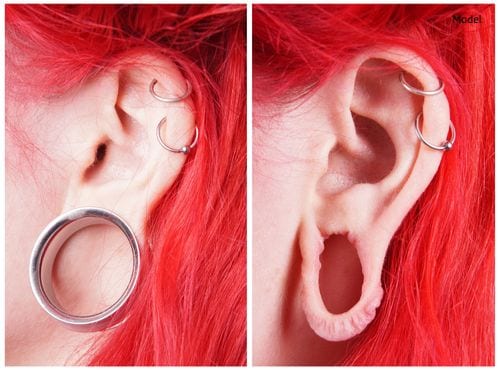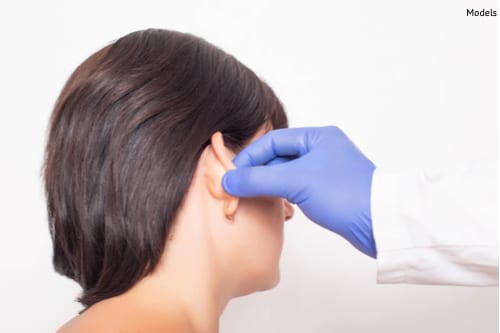Get an Ear Makeover With Earlobe Repair
2 Min Read
Every generation has its defining look. For the youth of the early 2000s, fashion was defined by a desire to be different. Eye-catching punk and rocker styles became the norm, and ear gauges—which often involved stretching the earlobe to extreme lengths—skyrocketed in popularity.
It was almost a rite of passage to go into that piercing shop and start to get your ears stretched.
But things change as we get older, including the way we want to present ourselves. And while it may be easy to set aside the gauges themselves, their side effects may last longer than ever intended.
How Earlobes Are Damaged
The earlobes are fairly hardy, all things considered. But everything has a limit, and earlobes can sustain a tremendous amount of damage from modification or trauma.

An image showing the effects a large ear gauge can have on earlobes, leaving gaping holes and stretched tissue.
Using heavy earrings or piercings that are wide, such as ear gauges, cause a striking visual and physical effect that’s often hard to reverse.
Tears occur easier as tissue weakens from the weight or the stretching.
It can be disconcerting to still have gaping holes or torn lobes even years after your gauges and piercings have been removed.
Fortunately, earlobe repair surgery can fix the torn sections and return your earlobes back to normal condition in no time.
Who Needs Earlobe Repair?
Earlobe repair surgery can be useful to anyone who struggles with torn or stretched earlobes due to:
- Heavy earrings
- Previous ear gauges
- Injuries or trauma
Repair Those Tears: What Earlobe Repair Does
Earlobe repair is a fairly simple procedure. The area is first cleaned and prepared with local anesthesia before Dr. Pollack creates a tiny incision near where the split or hole is. From there, the skin can be cut and restitched together.

A plastic surgeon examines a patient’s ear before surgery.
Dr. Pollack uses what’s called a “mini-flap” to repair the ear, using an L-shaped pattern to restore the lobe back to its original shape. This method ensures a smoother healing process with less visible scarring.
The mini-flap method also tends to prevent “notching”, which happens if earlobe tissue isn’t lined up properly as it’s sutured, causing it to heal unevenly.
Recovery and Results
It can take a few weeks for patients to recover from earlobe repair surgery. There might be some soreness and discomfort, particularly in the first few days.
It’s crucial for patients to follow all postoperative instructions and keep surgical sites clean.
Ears should be restored back to their former shape and fully healed within six weeks after surgery. Ears may be re-pierced at this time if patients desire so.
Dr. Pollack will happily re-pierce patients’ repaired ears if they bring their own earrings, at no extra charge.
Want to learn more about earlobe repair?
Contact us online or call our San Diego offices at 858-450-9100 to schedule a consultation with Dr. Pollack soon.
